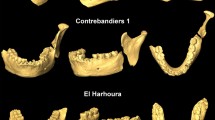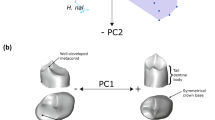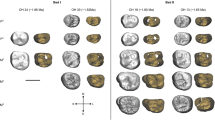Abstract
THE following observations seem to me to be of considerable interest in connexion with the genealogy of fossil types of men. So far back as 1923 I had photographed, side by side, the mandible of an Australian aboriginal, in the Anatomy Department of the University of Sydney, and a cast of the Heidelberg mandible. My object was to show the almost exact correspondence in size and shape of the teeth; in each case the tooth arches were extraordinarily alike in very many respects, but as at that time I could find no example of an Australian or other mandible of modern man which approached the ramus of the Heidelberg jaw in size and general shape, I let the matter stand.
This is a preview of subscription content, access via your institution
Access options
Subscribe to this journal
Receive 51 print issues and online access
$199.00 per year
only $3.90 per issue
Buy this article
- Purchase on Springer Link
- Instant access to full article PDF
Prices may be subject to local taxes which are calculated during checkout
Similar content being viewed by others
Author information
Authors and Affiliations
Rights and permissions
About this article
Cite this article
BURKITT, A. Neanderthal Man and the Natives of New Caledonia. Nature 122, 474–475 (1928). https://doi.org/10.1038/122474a0
Issue Date:
DOI: https://doi.org/10.1038/122474a0
Comments
By submitting a comment you agree to abide by our Terms and Community Guidelines. If you find something abusive or that does not comply with our terms or guidelines please flag it as inappropriate.



